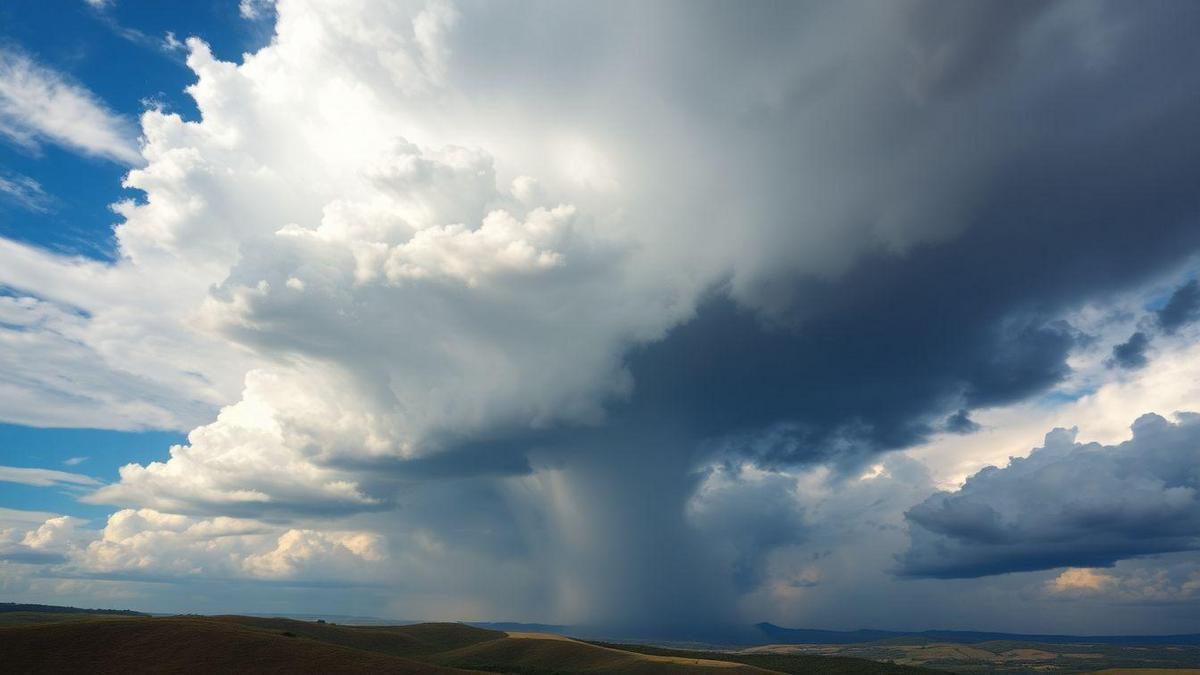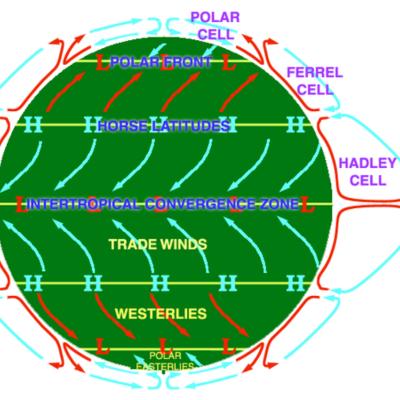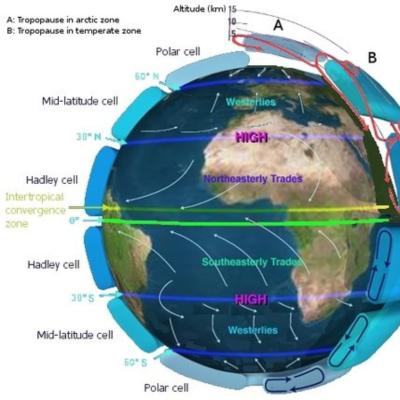Anúncios
Atmospheric convection cells are essential structures that move heat and moisture in the atmosphere, shaping the climate and influencing weather phenomena. They act as natural engines that, when intensified, can trigger large-scale storms. Understanding how they work helps us better comprehend the extreme events we experience.
These vertical air movements are especially important for the formation of massive storms. When warm air rises and meets cooler layers, instability forms, favoring heavy rain, thunder, and strong winds. Observing and studying these cells is fundamental to modern meteorology.
Anúncios

What Are Atmospheric Convection Cells
Convection cells are vertical air currents caused by temperature differences. When the ground heats up with sunlight, the nearby air also warms, becoming less dense. This air rises, while cooler air descends, creating a continuous cycle.
This process of rising and falling air happens constantly in the atmosphere and can be observed at various scales. From small whirlwinds to global climate systems, convection regulates the movement of heat on the planet. It also determines cloud and rain formation.
The simplest convective cells occur on hot, sunny days, resulting in isolated clouds. In more intense situations, they can evolve into clouds with significant vertical development. This includes cumulonimbus clouds, associated with severe storms.
The energy released by moisture condensation at higher altitudes further fuels the cycle. This latent heat intensifies convection and contributes to the development of complex weather systems. Thus, the cycle feeds itself, increasing the storm’s severity.
Formation of Massive Storms
Massive storms often originate from intense convective cells. When warm and humid air rises quickly, it forms a cloud with great energy potential. The more heat and moisture present, the stronger the storm.
During this process, the rising air encounters cooler temperatures in the upper layers. This leads to condensation and rain droplet formation, releasing heat and increasing instability. This feedback can create violent storms with wind and lightning.
If conditions are favorable — such as strong humidity, high temperature, and wind from different directions — these cells organize. This can result in systems like supercells, severe storms, and even hurricanes. These events pose significant risks to populations.
Storms formed by intense convection can last for hours and cover large areas. Torrential rains, hail, and tornadoes are examples of extreme effects. Therefore, detecting and monitoring these cells are priorities in meteorological centers.
How Atmospheric Convection Cells Work in the Formation of Massive Storms

Atmospheric convection cells are fundamental phenomena that play a crucial role in Earth’s atmospheric dynamics. They are responsible for transporting heat and moisture, influencing cloud formation and, consequently, the development of massive storms. Atmospheric convection occurs when heated air rises, creating a circulation that can intensify and generate extreme weather conditions. This process is essential not only for understanding storms but also for global climate patterns.
These convection cells are formed due to temperature and pressure differences in the atmospheric environment. When the sun heats the Earth’s surface, the air near the ground also warms. Warm air is less dense and therefore rises, while cooler, denser air descends to occupy the space left by the rising air. This movement creates a circulation that can intensify, leading to the formation of cumulonimbus clouds, often associated with severe storms. Additionally, interaction between different convection cells can result in complex weather phenomena such as hurricanes and summer storms.
Advantages of Understanding Atmospheric Convection Cells and Storm Formation
Understanding atmospheric convection cells and the formation of massive storms is fundamental for weather forecasting and natural disaster mitigation. By studying these phenomena, meteorologists can more accurately predict the occurrence of severe storms, allowing communities to prepare and protect themselves. This forecasting ability is vital, as massive storms can cause significant damage to infrastructure, agriculture, and most importantly, human lives.
Furthermore, understanding convection cells contributes to the advancement of climate science. With the growing concern about climate change, it is essential to understand how storms form and how they may be affected by global temperature changes. Research in this field can help develop adaptation and mitigation strategies, promoting better water and agricultural resource management in the face of extreme weather events.
Education about convection cells is also beneficial for the general public. When people have a basic understanding of how storms form, they can make more informed decisions about their safety during severe weather events. This includes knowing when to seek shelter and how to prepare for potential flooding or wind damage. Public awareness can therefore reduce the risks associated with natural disasters.
Finally, the study of atmospheric convection cells is a fascinating area of meteorology that continues to evolve. New technologies, such as satellites and simulation models, are enabling scientists to explore these phenomena in greater depth. This research not only enriches our scientific knowledge but can also lead to innovations in weather forecasting and understanding global climate patterns.
How Atmospheric Convection Cells Influence Climate Patterns

Atmospheric convection cells are fundamental in determining climate patterns in various regions of the planet. They act as engines that transport heat and moisture, creating high and low-pressure zones that in turn influence wind and precipitation patterns. This energy transport is essential for maintaining both global and local climate, affecting everything from temperature to humidity and cloud formation.
Convection cells also play an important role in the distribution of tropical and temperate climates. In tropical regions, intense convection can result in heavy rainfall and tropical storms, while in temperate regions, interaction between different convection cells can create more varied climate patterns. This dynamic is responsible for phenomena such as cold and warm fronts, which bring significant changes in weather conditions.
Additionally, atmospheric convection cells have a direct impact on the formation of high and low-pressure systems. When warm air rises, it creates low-pressure areas that can attract cooler, moister air, resulting in precipitation. On the other hand, high-pressure areas are often associated with drier and more stable weather. This interaction between pressure and temperature is one of the main factors shaping climate in different regions.
Lastly, climate change is affecting convection cells in complex ways. As global temperatures rise, the air’s ability to retain moisture also increases, potentially intensifying the frequency and severity of massive storms. Understanding how these changes affect atmospheric convection cells is vital for predicting future climate patterns and developing effective adaptation strategies.
How Atmospheric Convection Cells Influence Climate Patterns
Atmospheric convection cells have a significant impact on climate patterns around the world. They are responsible for forming pressure systems that affect weather conditions in different regions. Here are some ways these cells influence the climate:
Heat transport: Convection cells transport heat from equatorial regions to polar regions, helping regulate global temperature.
Cloud formation: Warm air rising in convection cells cools as it ascends, leading to cloud formation and, in many cases, precipitation.
Creation of high and low-pressure zones: Convection cells create low-pressure areas where warm air rises and high-pressure areas where cool air descends, influencing wind movement.
Intensification of massive storms: Intense convection can lead to the formation of severe storms, such as hurricanes and summer storms, which can cause significant damage.
Climate change: Global warming may alter the behavior of convection cells, potentially increasing the frequency and intensity of storms.
Interaction with other climate systems: Convection cells interact with other climate systems, such as ocean currents and atmospheric fronts, influencing regional and global climates.
These factors demonstrate how atmospheric convection cells are essential to understanding climate patterns. Ongoing research in this area is crucial to improve weather forecasting and develop strategies to address the impacts of climate change.
Did You Enjoy Learning More About Atmospheric Convection Cells and Massive Storm Formation?
Understanding atmospheric convection cells and their relationship to massive storm formation is a fascinating journey that connects us to the workings of nature. These phenomena not only shape the climate but also affect our daily lives, highlighting the importance of being informed and prepared.
If you found this topic interesting, keep exploring the world of meteorology and its complexities. Knowledge about how storms form and how we can protect ourselves from them is fundamental to our safety and well-being.
Frequently Asked Questions
What are atmospheric convection cells?
Atmospheric convection cells are air movements that transport heat and moisture in the atmosphere. This happens when warm air rises and cool air descends.
How do convection cells cause massive storms?
When warm air rises quickly, it forms huge clouds. These clouds can create very strong storms. So, the energy from convection cells helps form storms.
Where are convection cells most common?
These cells are common all over the world, but they usually appear in hot and humid regions, including tropical and equatorial areas.
What is the role of moisture in convection cells?
Moisture is essential! It helps warm air rise. When air rises and moisture condenses, we can see rain and even storms.
How can I know if a storm is caused by convection cells?
If you notice tall, dark clouds, that could be a sign. Also, if the weather changes quickly, it may be a convection cell at work.
